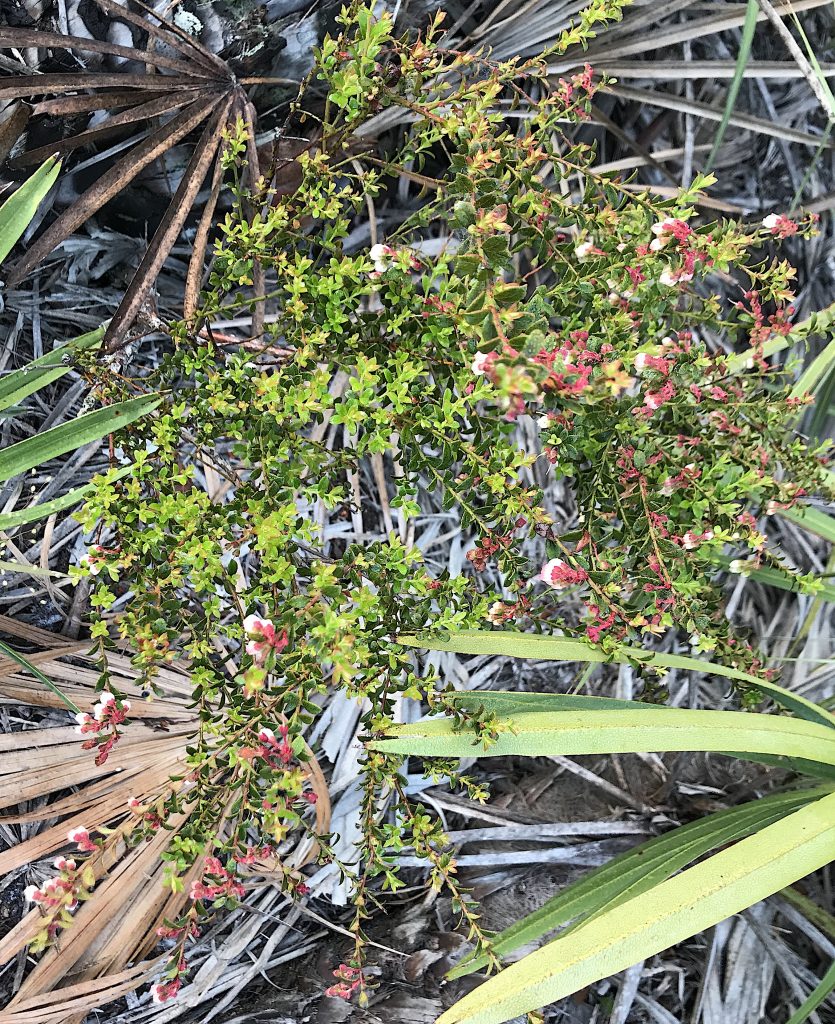
Blueberries are blossoming heavily. Photo by Green Deane
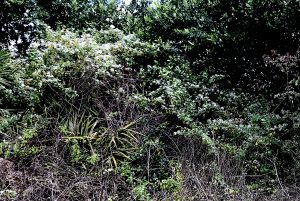
Blackberries in blossom on the Springs to Springs bike trail.
It’s not June that’s busting out all over but rather Vacciniums, mostly blueberries. Last week I had the opportunity to see V. elliottii in south Georgia. This Sunday we saw V. myrsinites and V. darrowii in bloom. Expect ripe berries in a month to six weeks. Blackberries were also in full bloom this week. They also usually are ripe sometime in April. And if we get ten days of good rain in the next three weeks look for a second flush of Ringless Honey Mushrooms. The seasons are not static.
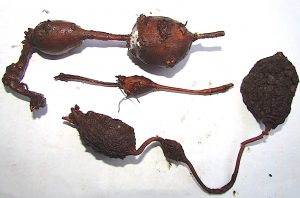
No other root has the growth pattern of the Groundnut east of the Rockies. Photo by Green Deane
The first export from the New World back to Europe was Sassafras wood. It was thought to be medicinal. The second export on any large scale was groundnuts, Apios americana. While gold fever later became a motive early explorations were for plants. John Smith, of Pocahontas fame, made careful botanical notes as he was good friends with the king’s gardener, John Tradescant. In his 909-page book, Florida Ethnobotany, Dr. Daniel Austin references Smith. In at least one case Austin prefers Smith’s observations over 400 years ago over that of a PhD. botanist in the 1930s. Smith incidentally, lived a full and a rather amazing life. You can read a little about him in my article about Spiderworts.
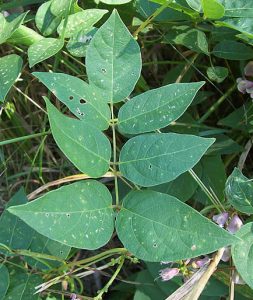
Groundnuts have leaflets of three, five and seven. Photo by Green Deane
We found some groundnut during as foraging class recently. No other plant east of the Rockies has a similar root growth pattern making it easy to identify. A legume with lumps on its root, it usually grow to about egg size but can be as large as a potato. It also has up to 26% protein, which is a whopping amount for a plant. The University of Louisiana developed a commercial cultivar and it can be bought on the internet if you don’t want to go find it. If folks ate groundnuts some 400 years ago — it was a staple for the natives from Maine to Florida — and it was shipped off to Europe as a food, and has been developed into a cultivar, why aren’t we eating it? Why isn’t it in the grocery stores? The answer is it takes a year to first establish itself. In the fast pace of modern agriculture that does not meet commercial practices. But it’s fine for people who like to grow their own food. You can read about the “lost crop” here.
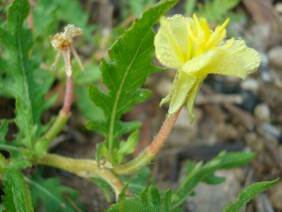
Oenothera laciniata, cutleaf evening primrose
There are two blossoms you might be seeing now. One is the non-edible vine Carolina jassamine (Gelsemium Sempervirens.) You will see it draping over fences and bushes. The other in the southern version of the Evening Primrose, generally considered not edible (but I haven’t proven that to myself.) The northern version of the Evening Primrose, Oenothera biennis, is called a “lost vegetable.” It was cultivated in Europe for about a century. There is a debate whether it is native to Europe or North America. Our Evening Primrose is O. laciniata, or the Cutleaf Evening-primrose. Unlike its northern sibling our local Evening Primrose does not grow tall, is a ground hugger, and is not considered edible. I have been meaning to try a little part of the blossom. A quarter of a century ago Forager Emeritus Dick Deuerling told me it was not edible. That said, Dick had texture issues and said he only ate the “good stuff.” So he could have been saying he didn’t eat it. It’s a plant I’ve been meaning to explore. The natives ate several other Evening Primroses including O. albicaulis, O. biennis, O elata ssp. hookeri, and O. triloba. Another evening Primrose you might find in the northern part of the state is O. fruticosa. It’s not considered edible, either.

Classes are held rain or shine or cold. (Hurricanes are an exception.) Photo by Kelly Fagan.
Foraging Classes: Traveling some this weekend, southeast Florida to northwest, Ft. Pierce to Gainesville
Saturday, March 20th, George LeStrange Preserve, 4911 Ralls Road, Fort Pierce, FL, 34981. 9 a.m. to noon. Meet in the parking lot.
Sunday, March 21st, Boulware Springs Park, 3420 SE 15th St., Gainesville, FL 32641. 9 a.m to noon, meet at the pavilion by the pump house.
Saturday, March 27th, Eagle Park Lake, 1800 Keene Road, Largo, FL 33771. 9 a.m. to noon. Meet at the pavilion near the dog park.
Sunday, March 28th, Mead Garden: 1500 S. Denning Dr., Winter Park, FL 32789. 9 a.m. to noon. The entrances is on the west side of the park on Denning.
Saturday, April 3rd, Florida State College, south campus, 11901 Beach Blvd., Jacksonville, 32246. 9 a.m. to noon. We meet at Building A next to the administration parking lot. Whether the bathrooms are open or not is always a problem at this location.
For more information on these clases, to prepay or sign up go here.

Green Deane videos are now available on a USB.
150-video USB would be a good spring present and is now $99. My nine-DVD set of 135 videos is being phased out. They are the same videos I have on You Tube. Some people like to have a separate copy. The USB videos have to be copied to your computer to play. They are MP4 files. My headache is getting my WordPress Order page updated to reflect this change. We’ve been working on it for several months. However, if you want to order the USB make a $99 “donation” using the link at the bottom of this page or here. That order form provides me with your address, the amount — $99 — tells me it is not a donation. Please include a snail-mail address.

Green Deane Forum
Want to identify a plant? Perhaps you’re looking for a foraging reference? You might have a UFO, an Unidentified Flowering Object, you want identified. On the Green Deane Forum we — including Green Deane and others from around the world — chat about foraging all year. And it’s not just about warm-weather plants or just North American flora. Many nations share common weeds so there’s a lot to talk. There’s also more than weeds. The reference section has information for foraging around the world. There are also articles on food preservation, and forgotten skills from making bows to fermenting food.
Also blooming now are paw paws. They’re a yellow blur from the interstate, usually along a fence, or inside a pasture. The shrub is two or three feet high. If you stop and look, it has large, three-petaled waxy blossoms that remind you of the Magnolia. You have found a paw paw.
Paw paws are common but elusive in this part of the world. Neither rare nor prolific yet they manage to hide well, even in plain sight! Kind of like persimmons, they are wall-flowers, not showy. More so the fruit starts out green and blends in well. And about the time it ripens to light green and yellow the woodland creatures are harvesting them. Here and gone. So finding the shrub this time of year by the blossoms is the easiest way to locate them. Dry open ground is a good place to look, which is why pastures near the road are often fruitful. It is also common to find them at the base of slash pines in scrub areas. We have several different species locally from dwarf versions with red blossoms to spindly tall shrubs with creamy-yellow blossoms. You can read more about them here.
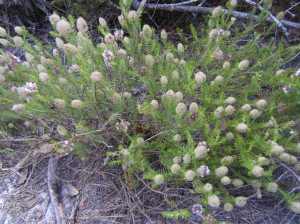
Florida Pennyroyal is also in blossom. Photo by Green Deane
If you are one to wander around sandy scrub in Florida this time of year you will see the low blooms of the Florida Pennyroyal. It’s quite an unusual plant in that it is monotypic, meaning the only plant in its genus. It’s found along the Central Florida Ridge though I have seen it also on the east coast of the state. There are a few plants in the Bahamas and maybe one or two in southern Georgia. It has the unmistakable aroma of pennyroyal. A species that looks vaguely similar, Florida Rosemary, has no noticeable strong aroma. Florida Pennyroyal used to be the third most common nectar plant in the state but fell off for some unknown reason and was replaced by Bidens alba, the Spanish Needles. Florida Pennyroyal was used extensively by the natives and has culinary uses. To read more about it go here.
This is weekly newsletter #449 If you want to subscribe to this free newsletter you can find the sign-up form in the menu at the top of the page.
To donate to the Green Deane Newsletter click here.

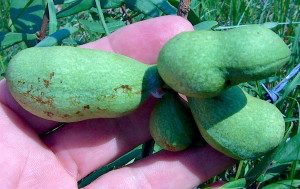

I never thought I would see you up here in south Georgia! And thanks for pointing out that what I’ve always been told is Honeysuckle is Carolina Jessamine.